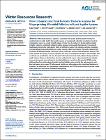| dc.contributor.author | Coxon, Catherine | en |
| dc.contributor.author | Gill, Laurence | en |
| dc.contributor.author | O'Connell, David | en |
| dc.date.accessioned | 2022-04-28T08:36:34Z | |
| dc.date.available | 2022-04-28T08:36:34Z | |
| dc.date.issued | 2022 | en |
| dc.date.submitted | 2022 | en |
| dc.identifier.citation | Vucinic L., O Connell D., Teixeira R., Coxon C., Gill L.W., Flow cytometry and fecal indicator bacteria analyses for fingerprinting microbial pollution in karst aquifer systems, Water Resources Research, 58, 2022, e2021WR029840 | en |
| dc.identifier.other | Y | en |
| dc.identifier.uri | http://hdl.handle.net/2262/98503 | |
| dc.description | PUBLISHED | en |
| dc.description.abstract | Microbial pollution of aquifers is a persistent water quality problem globally which poses
significant risks to public health. Karst aquifer systems are exceptionally vulnerable to pollution from fecal contamination sources as a result of rapid recharge of water from the surface via discrete pathways linked to highly conductive, solutionally enlarged conduits alongside strong aquifer heterogeneity. Consequently, rapid changes in microbial water quality, which are difficult to monitor with expensive and time-consuming conventional microbiological methods, are a major concern in karst environments. This study examined flow cytometric (FCM) fingerprinting of bacterial cells in groundwater together with fecal indicator bacteria (FIB) at nine separate karst springs of varying catchment size over a 14 month period in order to assess whether such a technique can provide faster and more descriptive information about microbial pollution through such karst aquifer systems. Moreover, the data have also been evaluated with respect to the potential of using turbidity as an easy-to-measure proxy indicator of microbial pollution in a novel way. We argue that FCM provides additional data from which enhanced insights into fecal pollution sources and its fate and transport in such karst catchments can be gained. We also present valuable new information on the potential and limitations of turbidity as an indicator of fecal groundwater contamination in karst. FCM has the potential to become a more widely used tool in the field of contaminant hydrogeology | en |
| dc.format.extent | e2021WR029840 | en |
| dc.language.iso | en | en |
| dc.relation.ispartofseries | Water Resources Research | en |
| dc.relation.ispartofseries | 58 | en |
| dc.rights | Y | en |
| dc.title | Flow cytometry and fecal indicator bacteria analyses for fingerprinting microbial pollution in karst aquifer systems | en |
| dc.type | Journal Article | en |
| dc.contributor.sponsor | Science Foundation Ireland (SFI) | en |
| dc.type.supercollection | scholarly_publications | en |
| dc.type.supercollection | refereed_publications | en |
| dc.identifier.peoplefinderurl | http://people.tcd.ie/cecoxon | en |
| dc.identifier.peoplefinderurl | http://people.tcd.ie/gilll | en |
| dc.identifier.peoplefinderurl | http://people.tcd.ie/oconnedw | en |
| dc.identifier.rssinternalid | 242567 | en |
| dc.identifier.doi | https://doi.org/10.1029/2021WR029840 | en |
| dc.rights.ecaccessrights | openAccess | |
| dc.contributor.sponsorGrantNumber | 13/RC/2092 | en |
| dc.subject.TCDTheme | Smart & Sustainable Planet | en |
| dc.subject.TCDTag | ENVIRONMENTAL ENGINEERING | en |
| dc.subject.TCDTag | GROUNDWATER POLLUTION | en |
| dc.subject.TCDTag | MICROBIAL-CONTAMINATION | en |
| dc.subject.TCDTag | WATER QUALITY | en |
| dc.identifier.orcid_id | 0000-0002-2911-9115 | en |
| dc.status.accessible | N | en |




